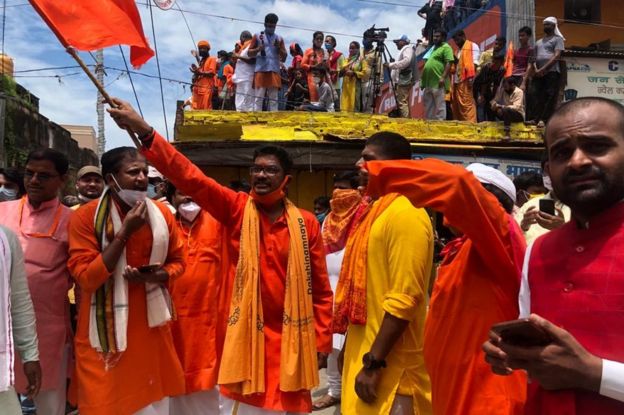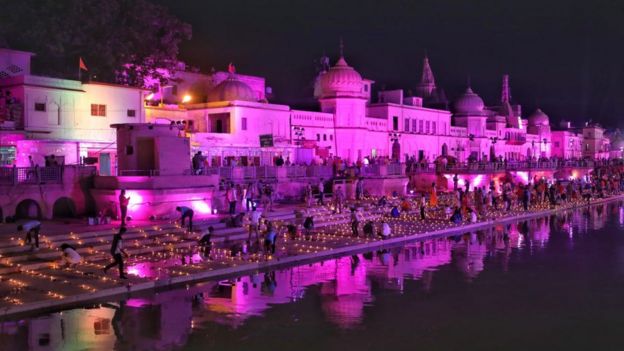India PM Modi establishes the framework for Ayodhya Ram sanctuary in the midst of COVID flood
 |
| Image Credit: BBC |
Hindus and Muslims asserted responsibility for the site for quite a long time. A year ago, the top court gave the site to Hindus, finishing a decades-in length fight in court.
The initiation comes in the midst of a gigantic flood in coronavirus cases in India.
The question, which returns over a century, has been one of India's thorniest legal disputes. The Supreme Court gave Muslims another plot of land in the city to build a mosque.
Mr. Modi laid an emblematic silver block in the sanctum sanctorum, or deepest haven, of the site as scores of lovers, viewed the occasion on mammoth screens over the city.
Due to Covid-19, the setting and encompassing territories were cordoned off, and get to was limited to invitees as it were.
BBC Hindi's Sarvapriya Sangwan, who is in Ayodhya, says hordes of individuals accumulated outside the scene, and cheered when they spotted Mr. Modi on his way to the site.
Talking not long after he established the framework stone, Mr. Modi started with the words, "Jai Siya Ram", rather than the more well-known trademark, "Jai Shri Ram", which has become a mobilizing sob for traditional Hindus in the nation.
Mr. Modi said that the site had been "freed", and a "stupendous house" would be at long last developed for Lord Ram who had been living "in a tent for quite a long time". He was alluding to an impermanent development that had housed the icon of Ram Lalla or newborn child Ram for over three decades while the legal dispute delayed.
The symbol was moved to an improvised sanctuary on the premises of the site prior to this year.
 |
| Image Credit: BBC |
Authorities said they would follow Covid-19 conventions, yet our columnist at the site depicted groups assembled out and about paving the way to it and past the blockades.
Individuals additionally climbed onto housetops to get a brief look at the setting, a significant number of whom were reciting "Jai Shri Ram". Most were not wearing veils or following social separating, she included.
Psalms about Lord Ram were played, and the streets decked with blossoms. Many shop fronts also were painted yellow and saffron banners set up all over the place - the two hues that Hindus think about propitious.
UP Chief Minister Yogi Adityanath and other senior BJP pioneers likewise went to the occasion.
Be that as it may, the initiation was a to some degree quieted issue in the midst of the pandemic. India has been detailing record everyday sums - it recorded more than 1.9 million cases and about 40,000 passings from the infection.
Uttar Pradesh, the state where Ayodhya is found, has affirmed more than 100,000 Covid-19 cases up until this point.
Indian TV channels have been offering one end to the other inclusion to the occasion.
Media reports state that aficionados from the nation over have been sending silver and gold - like coins, blocks, and bars - to use in the development of the sanctuary. Cops are said to have been requested to watch these valuable metals.
Upwards of 200,000 blocks engraved with "Shri Ram" (Lord Ram) that have been gathered from aficionados throughout the years will be utilized to assemble the establishment of the sanctuary, as per the Times of India.
 |
| Image Credit: BBC |
 |
| Image Credit: BBC |
 |
| Image Credit: BBC |
Chandrakant Sompura, the main modeler of the proposed sanctuary, told news site The Print that the structure would be planned in the "Nagara" style of sanctuary design - a mainstream north Indian sanctuary building style.
The internal sanctum of the sanctuary - where the icon of the essential divinity is housed - will be octagonal. The sanctuary will incorporate an enormous structure of three stories with 366 columns and five vaults.
Mr. Sompura said that a dedication divider to pay tribute to the individuals who were associated with the sanctuary development would be raised.
What was the Ayodhya issue about?
At the focal point of the column was a sixteenth-century mosque that was annihilated by Hindu crowds in 1992, starting uproars that slaughtered almost 2,000 individuals.
Numerous Hindus accept that the Babri Masjid was really developed on the remains of a Hindu sanctuary that was annihilated by Muslim trespassers.
Muslims state they offered supplications at the mosque until December 1949 when a few Hindus set an icon of Ram in the mosque and started to love the symbols.
Over the decades, the two strict gatherings went to court many occasions over who should control the site.
 |
| Image Credit: BBC |
What was the last decision?
In its consistent decision, the Supreme Court said that a report by the Archeological Survey of India (ASI) gave proof that the remaining parts of a structure "that were not Islamic" were underneath the structure of the annihilated Babri mosque.
The court said that, given all the proof introduced, it had established that the contested land ought to be given to Hindus for a sanctuary to Lord Ram, while Muslims would be given land somewhere else to develop a mosque.
It at that point guided the central government to set up a trust to oversee and administer the development of the sanctuary.
In any case, the court included that the destruction of the Babri mosque was contrary to the standard of law.


No comments